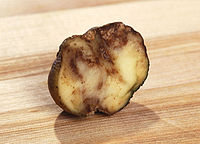- European Potato Failure
-
 A blighted potato tuber
A blighted potato tuber
The European Potato Failure was a food crisis caused by potato blight that struck Northern Europe in the mid-1840s. The time is also known as the Hungry Forties. While the crisis produced excess mortality and suffering across the affected areas, particularly harshly affected were the Scottish Highlands and, above all others, Ireland. Many people starved due to their inability to access other staple food sources.
Potatoes Rye Wheat Oats arable land consumption 1845 yield 1846 yield (%) (kg/capita daily) (% change on normal) Belgium 14% 0.5/0.6 kg −87% −43% −50% −10% n/a Denmark 3% 0.2/0.3 kg −50% −50% −20% −20% n/a Sweden 5% 0.5/0.6 kg −20–25% −20–25% −10% −10% n/a France App. 6% 0.5 kg −20% −19% −20% −25% n/a Württemberg 3–8% n/a −55% −51% −15% −24% n/a Prussia 11% 1.0/1.1 kg n/a −47% −43% −43% n/a Netherlands 11% 0.7 kg −71% −56% −47% −6% n/a Spain 2% low n/a n/a n/a n/a n/a Highlands of Scotland n/a high n/a −80% n/a n/a n/a Ireland 32% 2.1 kg −30% −88% n/a n/a −33% Source: Eric Vanhaute, et al., The European subsistence crisis of 1845–1850: a comparative perspective The effect of the crisis on Ireland is incomparable to all other places for the devastation it wrought, causing 1 million dead and another million refugees and spurring a century-long population decline. Excluding Ireland, the death toll from the crisis is estimated to be in the region of 100,000 people. Of this, Belgium and Prussia account for most of the deaths, with 40,000–50,000 estimated to have died in Belgium, with Flanders particularly affected, and a slightly smaller number, about 42,000 estimated to have perished in Prussia. The remainder of deaths occurred mainly in France, where 10,000 people are estimated to have died as a result of famine-like conditions.[1]
Aside from death from starvation and famine diseases, suffering came in other forms. While the demographic impact of famines are immediately visible in mortality, longer-term declines of fertility and natality can also dramatically affect population. In Ireland births fell by a third, resulting in about 0.5 million "lost lives". Declines elsewhere were lower but still remarkable: Flanders lost 20–30%, the Netherlands about 10–20%, and Prussia about 12%.[2]
Emigration to escape the famine centred mainly on Ireland and the Scottish Highlands. Elsewhere in the United Kingdom and on the continent, conditions were not so harsh as to completely eradicate the basics of survival so as to require mass migration of the sort experienced in Ireland and Scotland. Over 1 million[3] emigrated from the Scottish Highlands, many assisted by landlords and the government, mainly to North America and Australia, and is seen as a continuation of the Highland Clearances, with overtones of ethnic cleansing. Over 1 million[4] also left Ireland to the same locations, further fueling nationalist antagonism to Britain, and is sometimes perceived as an Irish holocaust.[citation needed] The global consequence of this was the creation of substantial Scottish and Irish diasporas.
Annual population change 1840–45 1845–46 1846–47 1847–48 1848–49 1849–50 1850–60 Belgium +1.1% +0.9% +0.9% +0.0% +0.5% +0.2% +0.7% Denmark +1.1% +1.0% +0.8% +1.0% +1.0% +1.0% +1.2% Sweden +1.1% +0.8% +0.6% +1.0% +1.3% +1.2% +1.0% France +0.5% +0.7% +0.4% +0.1% +0.3% +0.0% +0.5% Germany (total) +1.0% +1.0% +0.5% +0.2% +0.1% +0.9% +0.7% Prussia +1.3% +1.4% +0.8% +0.5% +0.4% +0.9% +1.0% Netherlands +1.1% +1.1% +0.3% −0.2% +0.1% +0.3% +0.7% United Kingdom* +1.2% +1.2% +0.7% +0.7% +0.7% +0,7% +1.3% Ireland +0.4% −0.2% −4% −4% −4% −4% −1.7% Notes: *excluding Ireland Source: Eric Vanhaute, et al., The European subsistence crisis of 1845–1850: a comparative perspective See also
- Great Irish Famine
- Highland Potato Famine
References
- ^ Eric Vanhaute, et al., The European subsistence crisis of 1845–1850: a comparative perspective
- ^ Eric Vanhaute, et al., The European subsistence crisis of 1845–1850: a comparative perspective
- ^ highlandclearances.info, Emigration for the Highlands
- ^ The famine in Ireland: Emigration and Migration
Categories:- Potatoes
- Famines
- 1840s in Europe
- Famines in Ireland
Wikimedia Foundation. 2010.
